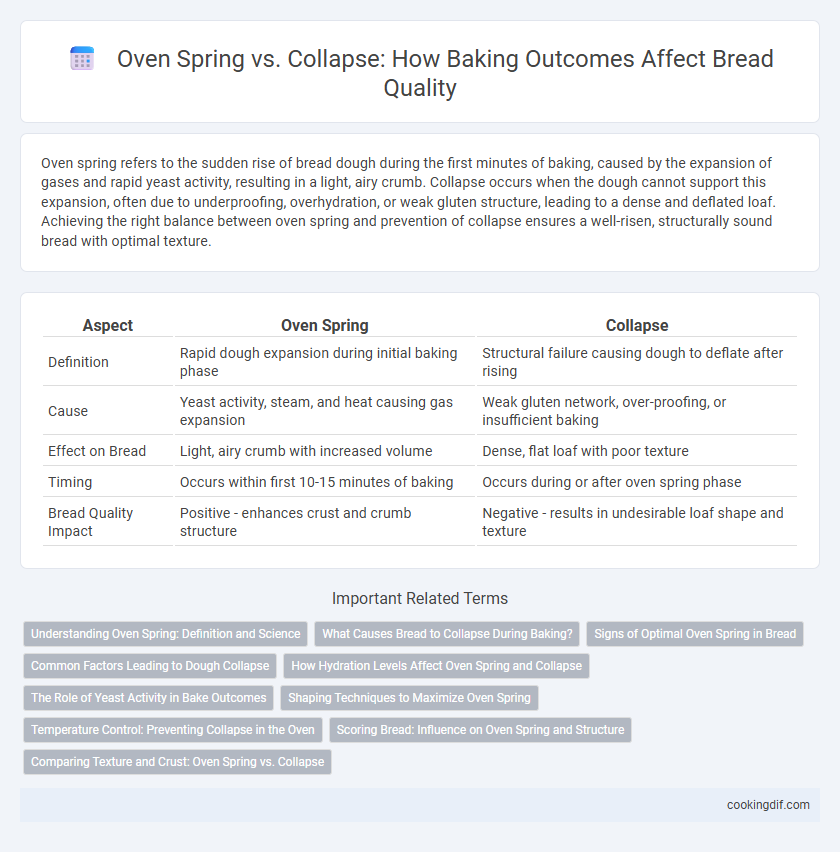Oven spring refers to the sudden rise of bread dough during the first minutes of baking, caused by the expansion of gases and rapid yeast activity, resulting in a light, airy crumb. Collapse occurs when the dough cannot support this expansion, often due to underproofing, overhydration, or weak gluten structure, leading to a dense and deflated loaf. Achieving the right balance between oven spring and prevention of collapse ensures a well-risen, structurally sound bread with optimal texture.
Table of Comparison
| Aspect | Oven Spring | Collapse |
|---|---|---|
| Definition | Rapid dough expansion during initial baking phase | Structural failure causing dough to deflate after rising |
| Cause | Yeast activity, steam, and heat causing gas expansion | Weak gluten network, over-proofing, or insufficient baking |
| Effect on Bread | Light, airy crumb with increased volume | Dense, flat loaf with poor texture |
| Timing | Occurs within first 10-15 minutes of baking | Occurs during or after oven spring phase |
| Bread Quality Impact | Positive - enhances crust and crumb structure | Negative - results in undesirable loaf shape and texture |
Understanding Oven Spring: Definition and Science
Oven spring refers to the rapid rise of bread dough during the first few minutes of baking, caused by the expansion of trapped gases and continued yeast activity under heat. This phenomenon is crucial for achieving a light, airy crumb and a well-developed crust. Understanding the balance between sufficient oven spring and avoiding collapse involves controlling dough hydration, proper proofing, and maintaining optimal oven temperature and steam levels.
What Causes Bread to Collapse During Baking?
Bread collapses during baking primarily due to insufficient gluten development, which weakens the dough's structure and limits its ability to retain gases produced by yeast fermentation. Overproofing causes the dough to exhaust its leavening potential, resulting in a fragile crumb that deflates when exposed to oven heat. Excessive moisture or underbaking can also contribute to collapse by creating a weak internal framework unable to support the loaf's expansion.
Signs of Optimal Oven Spring in Bread
Optimal oven spring in bread is characterized by a well-expanded and domed crust, indicating proper yeast activity and gas retention during baking. Visible signs include a pronounced volume increase, evenly distributed air pockets, and a crisp, blistered crust that suggests strong gluten development. These factors result in a light, airy crumb and a visually appealing loaf, contrasting sharply with collapse caused by under-proofing or sudden heat loss.
Common Factors Leading to Dough Collapse
Rapid oven spring depends on optimal yeast activity, sufficient gas retention, and proper gluten development; insufficient fermentation or over-proofing weakens the dough structure, causing collapse. Excess moisture or high oven temperatures can cause the bread's crust to set too quickly or too slowly, disrupting expansion and leading to dough collapse. Inadequate shaping or handling, such as degassing the dough excessively, reduces internal gas pressure, resulting in poor oven spring and eventual collapse.
How Hydration Levels Affect Oven Spring and Collapse
Higher hydration levels in bread dough enhance oven spring by producing more steam during baking, which helps the dough expand rapidly and develop a light, airy crumb. However, excessively high hydration can weaken the gluten network, increasing the risk of collapse as the dough lacks sufficient structure to support the rise. Optimal hydration balances moisture and gluten strength, ensuring maximum oven spring without compromising the dough's stability and final loaf shape.
The Role of Yeast Activity in Bake Outcomes
Yeast activity plays a crucial role in achieving optimal oven spring by producing carbon dioxide gas that expands the dough during baking. Insufficient yeast fermentation can lead to collapse as the gluten structure fails to support the gas bubbles, causing the bread to deflate. Monitoring yeast vitality and fermentation time ensures a strong rise and prevents post-bake collapse for a desirable crumb and texture.
Shaping Techniques to Maximize Oven Spring
Mastering shaping techniques such as creating surface tension through tight shaping and proper seam sealing significantly enhances oven spring by allowing the dough to expand evenly during baking. Scoring the dough before baking controls collapse by releasing steam and preventing uncontrolled ruptures. Using well-floured surfaces and gentle handling maintains the dough's structure, optimizing volume and crumb texture in the final bake.
Temperature Control: Preventing Collapse in the Oven
Precise temperature control in the oven is crucial for maximizing oven spring and preventing collapse in bread baking. Rapid temperature rise promotes steam formation and yeast activity, creating a strong crust that traps gases, while sudden drops or overheating can weaken gluten structure, causing the bread to deflate. Maintaining consistent heat between 220degC and 240degC during the initial baking phase ensures optimal expansion and structural integrity for a perfect loaf.
Scoring Bread: Influence on Oven Spring and Structure
Scoring bread before baking directs steam release and controls expansion, significantly enhancing oven spring by allowing the dough to expand without tearing. Properly executed scoring maintains the bread's internal structure, preventing collapse by evenly distributing stress during oven rising. The depth, angle, and pattern of scoring directly influence crust formation and crumb texture, ensuring an optimal bake outcome.
Comparing Texture and Crust: Oven Spring vs. Collapse
Oven spring significantly enhances bread texture by creating an airy crumb with well-developed gas pockets, resulting in a light and tender interior. In contrast, collapse leads to a dense, gummy crumb due to insufficient structural support during baking, producing a tight, heavy texture. Crust quality also differs; oven spring fosters a crispy, golden crust formed by rapid expansion and caramelization, whereas collapse often yields a pale, thin crust lacking proper firmness and coloration.
Oven spring vs Collapse for bake outcome Infographic

 cookingdif.com
cookingdif.com